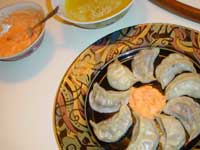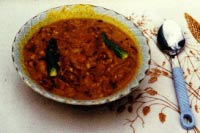Sikkim : Food & Drinks
Sikkim has its own unique dietary culture with specific cuisine and food recipes. Like anywhere else in the world, food habits here have evolved as the result of traditional wisdom and empirical experiences of generations. Today in many parts of the world these traditional foods have entered commercial production, and their recipes have become popular among people of different ethnic origin. In the Sikkim
Himalayas traditional foods are an integral part of the dietary culture of the various ethnic groups of people consisting of the Nepalese, Bhutias and Lepchas. Rice is the staple food. Meat and dairy products are also consumed depending on availability. Besides these, various traditional fermented foods and beverages, which constitute of about 20 per cent of the basic diet for long centuries (Table 1 & 2), are prepared and consumed.
The dietary-culture of this region is mostly reflected in the pattern of food production. Depending on the altitudinal variation, finger millet, wheat, buckwheat, barley, vegetable, potato, soybeans, etc. are grown. Some of the common traditional cuisine with their food recipes has been presented for introduction of dietary culture of the Sikkim Himalayas, as well as for product diversification.
 Momo
Momo
Momo, steamed dumpling prepared from wheat flour and meat/vegetable is very common Tibetan food. Momo has already entered commercial production and is well placed in menus of all local hotels/restaurant.
Momo
(steamed dumpling)
Serves 30 momos
Wheat flour 4 cups
Meat 750 g, minces
Onion 2 chopped
Salt 1 Teaspoon
Ginger 1 thumb-sized, finely chopped
Tomato achar
(pickle)
Tomato 2 large, boiled and crushed
Green chilies 4
Salt 1 Teaspoon
Boil tomato, crush and grind with green chilies in stone mortar. Add salt and mix well to give a thick past of tomato achar.
Preparation : Mix well wheat flour with 2 cups of water and knead into a stiff paste, roll out on a floured board till it is very thin. The rolled dough should be about 2 feet square. Cut in circle with the rim of tea cup. Place a circle of dough on your left hand, slightly stretch the edges and place about a teaspoon of filling in the centre. Then with your right thumb and forefinger pleat the dough together over the centre of the meat, forming a pin-wheel design. Your left thumb is used to tuck the minced meat down as you go, and the dumpling turns on your palm as you pleat around it. A special steamer locally called moktu is required. Filled up dumplings are placed on oiled racks, slightly separated in the moktu. Bottom of the moktu is filled with water and steam the dumplings for 20-25 min. Momo is ready to serve hot. Momo is eaten with meat/vegetable soup, and tomato achar.
Thukpa/ Gya-Thuk
Thukpa/Gya-thuk is a typical Tibetan style noodles in soup. Thukpa/Gya-thuk is very popular local cuisine also available in all restaurants and hotels of these regions.
Thukpa/Gya-thuk
(Noodle soup)
Serves 4 to 6
Egg noodles 300 g
Meat (beef/pork/mutton/chicken) 250 g, minced
Onion 2 finely chopped
Onion leaves 1 Tablespoon, chopped
Garlic 3 flakes, chopped
Green chili 4 sliced
For soup: About 3 litres of clear bone soup - beef/ pork/ mutton / chicken stock. Add 1 Teaspoon of salt.
Preparation : Fry chopped onions with garlic and green chilies, then add minced meat, fry for 10 min. Add salt to taste. Then keep aside after cooking.
Boil 4 litre of water vigorously, and drop noodles, boil for 2 min, stirring occasionally. Drain the noodles through a large sieve and run cold water over them to stop them from sticking. Squeeze the water from the noodles and transfer to a serving bowl. Pour hot soup into bowl with noodles. Put fried meat-onion mixture and finely chopped green onion leaves on top of it. Thukpa/Gya-thuk is ready to serve hot.
 Kinema
Kinema
Kinema is a traditional fermented soybean food having characteristic stringy property with unique flavour, commonly consume as a main side-dish curry served as meat substitute along with cooked rice in meals. Kinema serves as an inexpensive high source of plant protein food in the local diet. The word Kinema might have originated from the Limbu (one of the major castes of the Nepalis) dialect Kinambaa, Ki meaning fermented, nambaa means flavour.
Kinema curry
(fermented soybean)
Serves 6
Kinema 250 g
Onion 1 chopped
Tomato 1 sliced
Green chilies 3 pieces
Turmeric powder 1/4 Tablespoon
Salt 1 Teaspoon
Preparation : Heat oil and add chopped onions and fry till it becomes tender, add tomatoes and turmeric powder and fry for 2 min and then Kinema is fried, add salt, sliced green chilies and fry for 3-5 min. A little water is poured to make a thick curry, and cook for 5-7 min. Kinema curry is ready for serve with cooked rice. Sun-dried kinema is sometimes mixed with leafy vegetable to make mixed curry as side-dish.
Vatamas ko achar
(non-fermented soybean pickle)
Serves 6 to 8
Soybean 200 g
Ginger paste 1 Tablespoon
Chili powder 1 Teaspoon
Salt 1 Teaspoon
Mustard oil 1 Tablespoon
Preparation : Roast soybean in a pan, and grind. Add all the ingredients to soybean powder, and mix well, keep in a covered jar. It can be kept for several days. Serve Vatamas ko achar with cooked rice/Selroti